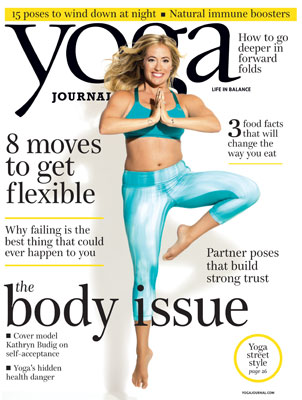
Subtle clues often provide the answers.
We like yoga as much as anyone else. We saw this picture on the latest cover and couldn’t resist making a few comments on this pose.
Yoga has many benefits. Our understanding is that in addition to the cognitive and spiritual effects of yoga, is that it helps to build your core.
At first look you may say that this woman has a few issues:
- she has a right pelvic shift and a left body lean
- She has slight head rotation to the right and a slight left head tilt
- you may have noticed that she appears to have more tone in the musculature on the right side of her face than on the left. Just look at the nasolabial fold as well as the corner of her mouth any area of wrinkling underneath her left orbit.
- You may have also noticed the subtle flexion and lack of external rotation of the right hip.
You may go on and think that she has a week right gluteus medius as well as an overactive quadratus lumborum on the left-hand side which may be causing the pelvic shift. The head tilt may be in compensation for the right side gluteus medius weakness and the subtle rotation may be an attempt to engage a tonic neck response. ( a tonic neck response is ipsilateral extension of the upper and lower extremity to the side of head rotation with contralateral flexion of the same counterparts.
You may have also noticed that the toes of the right foot are not dorsiflexed and that her hair appears to be flowing on the right side, and this is not the case at all, but rather she is either standing on a sloped surface or on the downward phase of a jump. According to the magazine it is the latter. If you caught this at first then congratulations: you are sharper than most. If not remember to always look for subtle clues.
Like Sir Topham Hat says in Thomas the Train: “ You didn’t get the whole story. What really happened is what really matters.
So why the mild facial ptosis on the left side? She could have had an old Bells palsy, or other form of facial paresis. Note that mostly the lower portions of the (left) face are affected (ie, below the eye). We remember that the upper portions of the face receive bilateral innervation but lower portions of the face unilateral innervation, from the contra lateral facial motor nucleus; this is why it could be a mild upper motor neuron lesion (micro infact, lack of cortical afferent input) and not an lower motor neuron lesion (like Bells Palsy). Why is this germane? Or is it not?
Stand in front of a mirror. Jump up in the air trying to assume the same pose as this woman does and what do you see. Make sure that you jump up from both legs and then bring one leg over and your hands in front of you in the “praying position”. You may want to have a friend take a snapshot of you performing this. You will notice that you have contralateral head rotation, a pelvic hike on the side opposite the leg that’s extended and a head tilt to the side that is flexed. You are attempting to stabilize your core as you’re going up and coming down.
What we are witnessing is a normal neurological phenomena. This gal merely seems to have some limited external rotation of her left hip. Now perform the same maneuver again but this time don’t externally rotate your leg as far as this woman does and what do you see. You should’ve seen an increase in the aforementioned body postures.
Subtle clues are often the key. Keep your eyes and ears open.
The Gait Guys. Helping the subtle to become everyday for you, with each and every post.
You must be logged in to post a comment.